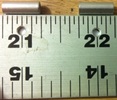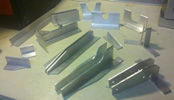


random user submitted photo
Calculations of spar pins
13 posts
• Page 2 of 2 • 1, 2
Re: Calculations of spar pins
Sorry I lost a post - not sure what happen
My comment about the distance between the bolt and pin had to do with a previous analysis post.
I adjusted for the vertical shear and the moment through the vector summation that I did. This takes into account the vertical force (shear) and the horizontal force (moment) and combines them into one resulting force.
The vertical distance between the bolt and pin is the primary geometric condition. In engineering this is call a couple. Think of it this way if the vertical distance was doubled I think it is easy to see that the forces on the pin and bolt are less. Likewise, if you just moved the pin say 2 feet in towards the fuselage the forces on the pin and bolt would for all purposes would not change.
I hope this makes it clearer.
My comment about the distance between the bolt and pin had to do with a previous analysis post.
I adjusted for the vertical shear and the moment through the vector summation that I did. This takes into account the vertical force (shear) and the horizontal force (moment) and combines them into one resulting force.
The vertical distance between the bolt and pin is the primary geometric condition. In engineering this is call a couple. Think of it this way if the vertical distance was doubled I think it is easy to see that the forces on the pin and bolt are less. Likewise, if you just moved the pin say 2 feet in towards the fuselage the forces on the pin and bolt would for all purposes would not change.
I hope this makes it clearer.
- paulonex
- Posts: 14
- Joined: Mon May 12, 2014 2:23 pm
Re: Calculations of spar pins
Paul,
The bolts are loaded in shear, so tension and compression does not matter to the bolt and pin. The wing spar holes will see compression on the top and tension on the bottom.
The bolts are loaded in shear, so tension and compression does not matter to the bolt and pin. The wing spar holes will see compression on the top and tension on the bottom.
Bryan Cotton
Poplar Grove, IL C77
Waiex 191 N191YX
Taildragger, Aerovee, acro ailerons
dual sticks with sport trainer controls
Prebuilt spars and machined angle kit
Year 2 flying and approaching 200 hours December 23
Poplar Grove, IL C77
Waiex 191 N191YX
Taildragger, Aerovee, acro ailerons
dual sticks with sport trainer controls
Prebuilt spars and machined angle kit
Year 2 flying and approaching 200 hours December 23
-

Bryan Cotton - Posts: 5493
- Joined: Mon Jul 01, 2013 9:54 pm
- Location: C77
Re: Calculations of spar pins
Bryan
You are correct the bolt and pin at the interface between the members is in shear, it is also in bearing against the plates ( the other test I did looks at that condition)
These forces are caused by the tension and compression forces on the joint. When the top bolt connection is in compression (pushing in on the inner spar) the bottom pin connection is in tension ( pulling on the inner spar). This is what transfers the moment from the outer spar to the inner spar. Hopefully that better explains what is going on. Engineers use what is call a free body diagram to show and explain where these forces are coming from and going to. My fear is if you are not use to looking at these they would cause more not less confusion.
I think you agree that the plates can see a tension or compression force and using Newton's third law "equal and opposite forces"
the pin and bolt then also see these forces.
As a practical matter the pin can only exerts a compression force on the plates which in tern creates a tension in the structure "behind" the bolt or pin.
In the end, the real question is can the pin , bolt and plates take these loads.
Sonex did a test at 10g's but did not show or document to us what if any residual distortions in the elements existed after the test. My very limited understand of the aircraft design standard is the elements needed to show no residual distortion to say it "Passed" the test. Given my calculations I would be VERY surprised that permanent deformations were not present after that test.
I think we have Killed this topic based on Our collective knowledge of the issue. Hopefully somebody with a strong structural engineering background in aircraft design can weigh in and give us a good explanation of what I'm missing or confirm my opinion.
PS If your wondering about my strange post times it is because I'm in the Netherlands ( Zulu +1)
You are correct the bolt and pin at the interface between the members is in shear, it is also in bearing against the plates ( the other test I did looks at that condition)
These forces are caused by the tension and compression forces on the joint. When the top bolt connection is in compression (pushing in on the inner spar) the bottom pin connection is in tension ( pulling on the inner spar). This is what transfers the moment from the outer spar to the inner spar. Hopefully that better explains what is going on. Engineers use what is call a free body diagram to show and explain where these forces are coming from and going to. My fear is if you are not use to looking at these they would cause more not less confusion.
I think you agree that the plates can see a tension or compression force and using Newton's third law "equal and opposite forces"
the pin and bolt then also see these forces.
As a practical matter the pin can only exerts a compression force on the plates which in tern creates a tension in the structure "behind" the bolt or pin.
In the end, the real question is can the pin , bolt and plates take these loads.
Sonex did a test at 10g's but did not show or document to us what if any residual distortions in the elements existed after the test. My very limited understand of the aircraft design standard is the elements needed to show no residual distortion to say it "Passed" the test. Given my calculations I would be VERY surprised that permanent deformations were not present after that test.
I think we have Killed this topic based on Our collective knowledge of the issue. Hopefully somebody with a strong structural engineering background in aircraft design can weigh in and give us a good explanation of what I'm missing or confirm my opinion.
PS If your wondering about my strange post times it is because I'm in the Netherlands ( Zulu +1)
- paulonex
- Posts: 14
- Joined: Mon May 12, 2014 2:23 pm
13 posts
• Page 2 of 2 • 1, 2
Who is online
Users browsing this forum: No registered users and 21 guests







